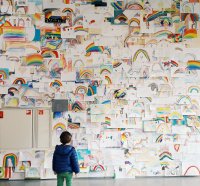Incorporating LGBTQIA+ Content in History Lessons
An inclusive history curriculum benefits all students by providing mirrors to their own lives and windows into others’ lived experiences.
Your content has been saved!
Go to My Saved Content.New state history–social science frameworks that include the experiences, perspectives, and contributions of LGBTQIA+ people signal an exciting shift in our discipline. Students are able to “appreciate the complexity of the past, think critically and expansively about possibilities for change in the future, and discover the roles that they can play in achieving an inclusive and respectful society,” as stated by the Committee on LGBT History in a report on California’s FAIR Education Act.
Teachers may not have exposure to content-specific training around these topics, but they can find meaningful ways to integrate LGBTQIA+ content into the history curriculum by depoliticizing the conversation, enhancing content, and connecting the integration to student well-being.
Depoliticize the Conversation
A thorough study of history requires students to engage with and analyze the perspectives and experiences of many groups of people. Identity, citizenship, social construction, cultural traditions, power, oppression, and activism are themes by which students can, and should, study the LGBTQIA+ experience. By omitting the critical contributions made by LGBTQIA+ people or by not identifying them as part of the LGBTQIA+ community, students are denied a comprehensive history education. All students deserve learning journeys that include both windows—examinations of the unfamiliar—and mirrors—reflections of their own lives and experiences.
It is important to reinforce that curriculum representation is not an in-depth examination of sexuality or an endorsement of a social-political agenda. Providing students with the opportunity to examine the experiences and contributions of many groups differs from detailing an individual’s personal life.
Students study the history of religions as part of K–12 social studies standards, not with the objective of proselytization, but so that students can understand the major tenets and foundational elements of different religious groups. In much the same way, the representation of LGBTQIA+ people in curricula helps students understand the contributions of all individuals that shape our historical story. This type of historical knowledge and understanding is the foundation of a vital element of democratic citizenship: inclusion and acknowledgment of different perspectives.
Integrate Into Content
Look for concrete ways to weave LGBTQIA+ content into the curriculum. The Four-Tiered Approach can be effectively used to create inclusive lessons that extend beyond the heroes-and-holidays method.
Level 1: Contributions: Students study leaders and major events in LGBTQIA+ history. This type of approach might include study of notable events like the Stonewall Riots.
Level 2: Additive: As students study a particular historical time period, LGBTQIA+ content is also presented. Additive elements to a learning unit on the 1920s, for example, could include study of Langston Hughes, bohemian gathering spaces in New York City, or the advent of an advocacy for gay rights.
Level 3: Transformation: Students consider history from a range of perspectives. They could study the industrial revolution through a lens of gender diversity and changing social mores. They could examine how same-sex friendships, changing ideas about gender expectations, and the separate spheres of society occupied by men and women influenced urbanization.
Level 4: Social Action: Students are given opportunities to engage critical learning experiences about LGBTQIA+ history and apply them to challenges in their communities. As students learn about historic struggles for equality, they could engage in civic action by starting a club at their school or volunteering with community agencies that support LGBTQIA+ people.
Another way to integrate content is to offer materials that support LBGTQIA+ history. The Conscious Kid offers a list of LGBTQIA+ books for children. The ONE Archives Foundation provides many free standards-aligned lesson plans, including one that explores the expansion of LGBTQIA+ rights in the context of the civil rights movement and another that examines the role of female impersonation in World War I.
Teaching Tolerance provides teachers with educational materials that address issues of diversity, identity, justice, and action. Their Queer America podcasts are excellent sources for better understanding the experiences and “hidden history” of LGBTQIA+ people.
Connect to Well-Being
There is a connection between representation in curricula and student well-being. Only “1 in 5 LGBTQ students were ever taught positive representations of LGBTQ people, history, or events in their classes,” according to a 2017 survey. Research indicates that the exclusion of LGBTQIA+ people and events from history curricula perpetuates negative stereotypes and increases bullying of LGBTQIA+ young people.
Curriculum that includes positive representations, however, helps promote respect for LGBTQIA+ students and improve students’ overall school experience. According to one survey, students who see themselves/their identified group represented in curricular materials maintain better school attendance, feel safer at school, and have higher levels of engagement with their school communities.
Inclusive curricula can extend to classroom decor that celebrates the contributions of the LGBTQIA+ community. In elementary classrooms, images of families could include those with two moms and/or two dads. Pictures of civic engagement could feature LGBTQIA+ political leaders or images of demonstrations for equality. In secondary learning spaces, the rainbow flag could be displayed with information about its origin and significance.
Creating an environment of inclusion promotes engagement for all students and provides them with opportunities to explore the many experiences of LGBTQIA+ people: triumphant, courageous, oppressed, liberated, and, most important, seen.
